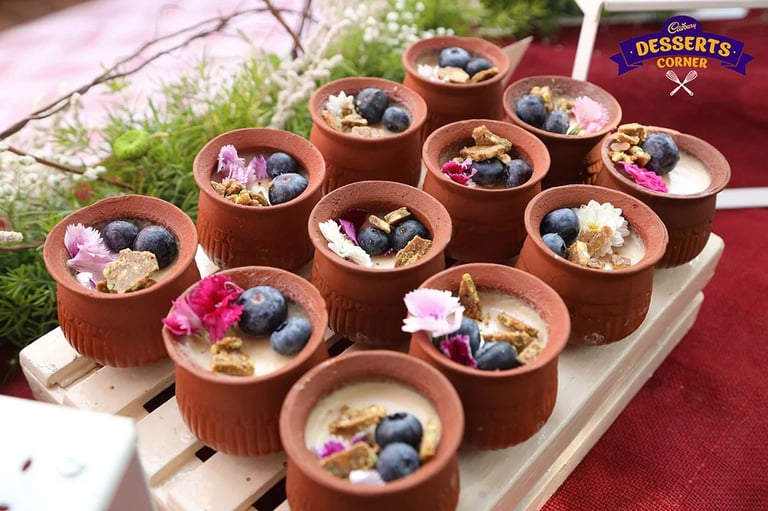Home![]() Articles
Articles![]() The History of the Kulfi, A Frozen Dessert That Came About Before Freezers Did
The History of the Kulfi, A Frozen Dessert That Came About Before Freezers Did
Kulfi is a beloved dish with unclear origins. But understanding how it was made and frozen is certainly going to make one value and enjoy it more.

Similar to the ice cream, kulfi is a frozen milk dessert, originating from the Indian subcontinent, but which has been around much longer than ice cream. Also denser and creamier than ice cream, it also comes in countless flavors like pista kulfi, paan kulfi, rose kulfi, mango kulfi and more. The word kulfi comes from the Persian qulfi which means ‘covered cup’. Many suggest that it originated from Delhi in the 16th century, from the Mughal empire.
To make it, sweetened and flavored milk is cooked over a low flame for a long time. It's stirred continuously so that it doesn't stick to the sides of the kadhai. This process condenses the milk, thickens it, caramelizes the sugar and gives the kulfi its unique taste. The mughals often added pistachios or saffron for added flavor. Some parts of Mughal territories had snowfall and glaciers, which meant the kingdom had access to ice. The ice was brought from the himalayas to cities like delhi and lahore through a system of human runners, horses, bullock carts and boats. The blocks of ice were carefully cut out, wrapped in cotton and jute, and sprinkled with saltpeter, a type of salt that helps with refrigeration. Saltpeter to transport ice is mentioned in the Ain-i-Akbari, a record of Akbar’s rule. It was then sealed in wooden boxes with layers of wooden chips. With all these layers, it traveled well. Once in the cities, it was taken to specially built and temperature controlled ice pits, which were essentially deep underground chambers.

But despite this, the kulfi’s exact origins remain unclear. Mughals were heavily infuelnced by the Persian cuisine and it's possible that this frozen dessert came from Persia or Samarkand, where dishes like falooda and sorbets have existed since 500 BCE. The food historian Charmaine O’Brien suggests that, “the Mughals appropriated the concept and elaborated on it to create the creamy, perfumed dessert that it is now.”
So once the flavored milk was cooked and cooled, it was poured into molds like mud pots or kulhads, and sealed. These were then submerged in clay pots filled with ice and salt. The pots were sealed and the mixture eventually froze, without any of those annoying ice crystals that come with modern refrigeration. The process is called matka kulfi and can still be found in use today.
While kulfi, in earlier years, was treated as an unhygienic street food, in recent years it has grown in popularity again. It's now served in high end restaurants and enjoyed by more people on the streets as well. It is the dense and creamy texture that makes it such a favorite of most people. It's also popularly served with falooda, the thin pink vermicelli sitting generously atop the kulfi. But despite the many variations and experiments in flavor, the pistachio kulfi with rose petals continues to be the uncontested favorite of kulfi eaters everywhere.

So here’s a simple kulfi recipe that you can make yourself and enjoy.
Ingredients:
- 3 cups whole milk
- 80 gms mawa or khoya
- 3 tbsp white sugar
- ⅕ tbsp rice flour OR 1 tbsp cornstarch
- 3 tbsp milk
- 20 pistachios, shelled and unsalted
- 20 almonds
- ½ tsp cardamom powder
- 1 tsp rose water
- A pinch saffron strands, crushed
Directions:
- In a kadhai, heat milk on a low flame for about 20 minutes. The milk will reduce and thicken. Keep stirring so that it doesn't stick to the sides and doesn't burn from the bottom.
- Grate khoya to a fine texture and set aside.
- Crush the pistachios and almonds in a grinder and set aside.
- Crush the cardamom to a powder and set aside.
- Mix the rice flour into the 3 tbsp milk and set aside.
- After the milk in the kadhai has simmered, add the sugar and mix well until it dissolves.
- Then add the rice flour paste and stir well so that no lumps form.
- After a few minutes, once the mixture has thickened, add the khoya, powdered almonds and pistachios and cardamom powder. Stir well.
- Turn off the heat and add the rose water and saffron. Set aside to let the mixture cool at room temperature.
- Then pour the mixture into molds and freeze overnight. Serve chilled.























